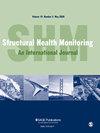前向模型驱动结构健康监测策略中的层次验证与验证
IF 5.7
2区 工程技术
Q1 ENGINEERING, MULTIDISCIPLINARY
Structural Health Monitoring-An International Journal
Pub Date : 2023-11-08
DOI:10.1177/14759217231206698
引用次数: 0
摘要
本文提出了一个正向模型驱动方法在结构健康监测(SHM)中的示范应用,结合了层次验证方法。该方法的一个关键原则是,可以构建一个能够在整个系统级别诊断损坏的SHM系统,而无需在其开发过程中使用完整的系统损坏状态数据;实现这一点将非常有影响,因为系统级损坏状态数据通常是不可获得的(以前的SHM方法,如数据驱动的SHM,由于依赖这些数据而受到阻碍)。这是通过在结构的子装配级别上对损坏模型执行验证活动来实现的。本文的重点是损伤检测和评估,尽管该方法为扩展到其他损伤识别活动(如损伤定位和预测)提供了自然的基础。本研究的重点是模型驱动方法的两个关键要素:预测子结构模型的验证及其在装配模型中的应用。最后以一个实验室规模的桁架桥结构为例进行了论证。本文章由计算机程序翻译,如有差异,请以英文原文为准。
Hierarchical verification and validation in a forward model-driven structural health monitoring strategy
This paper presents a demonstrative application of a forward model-driven approach to structural health monitoring (SHM), incorporating hierarchical validation methods. A key tenet of the approach is that an SHM system can be constructed that is capable of diagnosing damage at the full system level, without full system damage-state data having been used in its development; achieving this would be highly impactful as the system-level damage state data is generally not feasible to acquire (previous SHM methods such as data-driven SHM have been hindered by their dependence on these data). This is achieved by carrying out validation activities on the damage model at the subassembly level of the structure. The particular focus of the present paper is on damage detection and assessment, although the approach offers a natural basis for extension to other damage identification activities such as damage location and prognosis. The present study focuses on two of the key elements of the model-driven approach: validation of the predictive substructure models and their application in the assembled model. The ideas discussed are demonstrated in a case study based on a laboratory-scale truss bridge structure.
求助全文
通过发布文献求助,成功后即可免费获取论文全文。
去求助
来源期刊
CiteScore
12.80
自引率
12.10%
发文量
181
审稿时长
4.8 months
期刊介绍:
Structural Health Monitoring is an international peer reviewed journal that publishes the highest quality original research that contain theoretical, analytical, and experimental investigations that advance the body of knowledge and its application in the discipline of structural health monitoring.

 求助内容:
求助内容: 应助结果提醒方式:
应助结果提醒方式:


